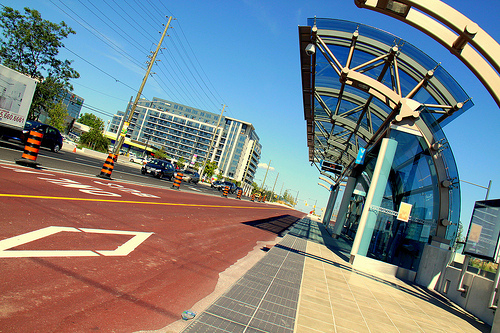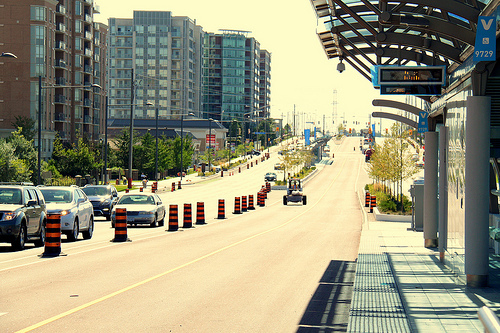Suburban Toronto’s Viva offers lessons for Montgomery BRT
Can high-quality bus rapid transit work in a suburban context like Montgomery County? Yes, if there’s effective branding and quality infrastructure. That’s the lesson from Viva, the BRT network serving York Region in suburban Toronto.
As the Montgomery County BRT proposal heads to the County Council this fall, residents and community leaders may want to look to York Region for a good precedent. Montgomery and York are strikingly similar jurisdictions. Both are similarly sized and part of a major metropolitan area of similar size, with commuter rail, subway, and multiple bus systems, along with a busy road and highway network.
| Montgomery County | York Region | |
| Total Population | 1,004,709 | 1,032,534 |
| Persons per square mile | 1,978.2 | 1,517 |
| Median household income | $95,660 | $89,099 (2006 Canadian dollars) |
| Housing units | 377,575 | 334,447 |
| Metropolitan area | 5,860,342 (Washington) | 5,583,064 (Toronto) |
Data from US and Canadian Censuses.
Each region has seen large population gains in the most recent decades and along with it, longer commutes and more congestion. Both traditionally contain some of their regions’ more affluent places, but are experiencing an influx of immigrants, young people, and low-income families. And each community is beginning to urbanize, with the densest development along major transportation corridors.
Viva launched in 2005 as a “BRT lite” system with 5 lines totaling some 56 miles along the municipality’s main corridors. The system offers frequent service, coming every 5 minutes in the peak hour on the busiest corridors. Like many BRT systems, Viva has limited stop service, off-board fare collection, articulated “fancy buses,” comfortable stations, and other amenities to attract drivers onto transit. Currently, York Region is adding the final ingredient: median-lane “rapidways,” giving buses their own dedicated lanes on the busiest corridors.
Branding has become increasingly important for BRT systems around North America, like Colorado’s dinosaur-themed VelociRFTA, helping to combat “bus stigma.” Viva invested heavily on branding during the system’s inception, casting it as “Frequent, convenient, modern, innovative, fun, and environmental.” It was the first public transit service in Canada to use “lifestyle marketing,” focusing not on the BRT service itself, but on the lifestyle it provides.
“In all of our advertising, we never show a bus,” says Graham Carey, Project Director for the York Consortium. “It shows a lifestyle that people can achieve by taking transit. They’ll be able to afford more things, take more time for themselves.”
Viva’s marketing campaign includes partnering with businesses, offering discounts on monthly passes, appointing transit ambassadors for high schools and “Team Viva” at colleges, and a transit safety program for children. The agency also does dozens of community outreach campaigns focusing on environmental impacts and seasonal benefits: bus riders don’t have to shovel out their cars in winter or pay high gas prices in summer.
Viva put out brand awareness surveys 18 months after opening and found that both users and nonusers understood what the service was about. They were aware of characteristics such as off board fares and frequent service.
Carey attributes Viva’s success to effective marketing and community outreach. The system won awards for both marketing and overall service. Since 2005, ridership for both BRT and more traditional bus service has increased by 26 percent to over 22 million riders per year. The busiest Viva line counts about 18,000 boardings on weekdays, which is less than half of the 44,000 forecasted daily boardings for BRT on Rockville Pike in Montgomery County.
The system’s second phase, dubbed VivaNext, is currently under construction. The transit agency has just opened its first “rapidway,” or exclusive median busway. There are plans to convert these lines to light rail in the future.
Giving buses dedicated lanes from the beginning is considered critical for a successful BRT service, and especially so in a place with heavy congestion such as Montgomery County. Yet Viva’s initial success without dedicated lanes shows that there are many important improvements that can be made to attract choice riders. It will be interesting to watch Viva unroll its first “gold standard” line and watch their success grow.
Montgomery officials are considering taking a bold and progressive step with their ambitious BRT plan. Thankfully, they can look to others who have gone before them and found success. York’s Viva shows how branding and effective marketing can help lure drivers out of their cars.



